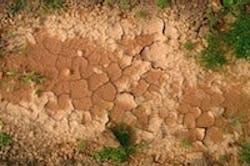California Governor Issues Mandatory Water Reductions
Following the lowest snowpack ever recorded and with no end to the drought in sight, California Gov. Edmund G. Brown Jr. announced actions that will save water, increase enforcement to prevent wasteful water use, streamline the state's drought response and invest in new technologies that will make California more drought resilient.
"Today we are standing on dry grass where there should be 5 ft of snow. This historic drought demands unprecedented action," Gov. Brown said. "Therefore, I'm issuing an executive order mandating substantial water reductions across our state. As Californians, we must pull together and save water in every way possible."
For more than two years, the state's experts have been managing water resources to ensure that the state survives this drought and is better prepared for the next one. Last year, the governor proclaimed a drought state of emergency. The state has taken steps to make sure that water is available for human health and safety, growing food, fighting fires and protecting fish and wildlife. Millions have been spent helping thousands of California families most impacted by the drought pay their bills, put food on their tables and have water to drink.
For the first time in state history, the governor has directed the State Water Resources Control Board to implement mandatory water reductions in cities and towns across California to reduce water usage by 25%. This savings amounts to approximately 1.5 million acre-ft of water over the next nine months.
To save more water now, the order will also:
- Replace 50 million sq ft of lawns throughout the state with drought tolerant landscaping in partnership with local governments;
- Direct the creation of a temporary, statewide consumer rebate program to replace old appliances with more water and energy efficient models;
- Require campuses, golf courses, cemeteries and other large landscapes to make significant cuts in water use; and
- Prohibit new homes and developments from irrigating with potable water unless water-efficient drip irrigation systems are used, and ban watering of ornamental grass on public street medians.
The order calls on local water agencies to adjust their rate structures to implement conservation pricing, recognized as an effective way to realize water reductions and discourage water waste.
Agricultural water users—which have borne much of the brunt of the drought to date, with hundreds of thousands of fallowed acres, significantly reduced water allocations and thousands of farmworkers laid off—will be required to report more water use information to state regulators, increasing the state's ability to enforce against illegal diversions and waste and unreasonable use of water under the order. Additionally, the action strengthens standards for Agricultural Water Management Plans submitted by large agriculture water districts and requires small agriculture water districts to develop similar plans. These plans will help ensure that agricultural communities are prepared in case the drought extends into 2016.
Additional actions required by the order include:
- Taking action against water agencies in depleted groundwater basins that have not shared data on their groundwater supplies with the state;
- Updating standards for toilets and faucets and outdoor landscaping in residential communities and taking action against communities that ignore these standards; and
- Making permanent monthly reporting of water usage, conservation and enforcement actions by local water suppliers.
The order:
- Prioritizes state review and decision making of water infrastructure projects and requires state agencies to report to the governor's office on any application pending for more than 90 days;
- Streamlines permitting and review of emergency drought salinity barriers—necessary to keep freshwater supplies in upstream reservoirs for human use and habitat protection for endangered and threatened species;
- Simplifies the review and approval process for voluntary water transfers and emergency drinking water projects; and
- Directs state departments to provide temporary relocation assistance to families who need to move from homes where domestic wells have run dry to housing with running water.
Source: Office of Gov. Edmund Brown Jr.
